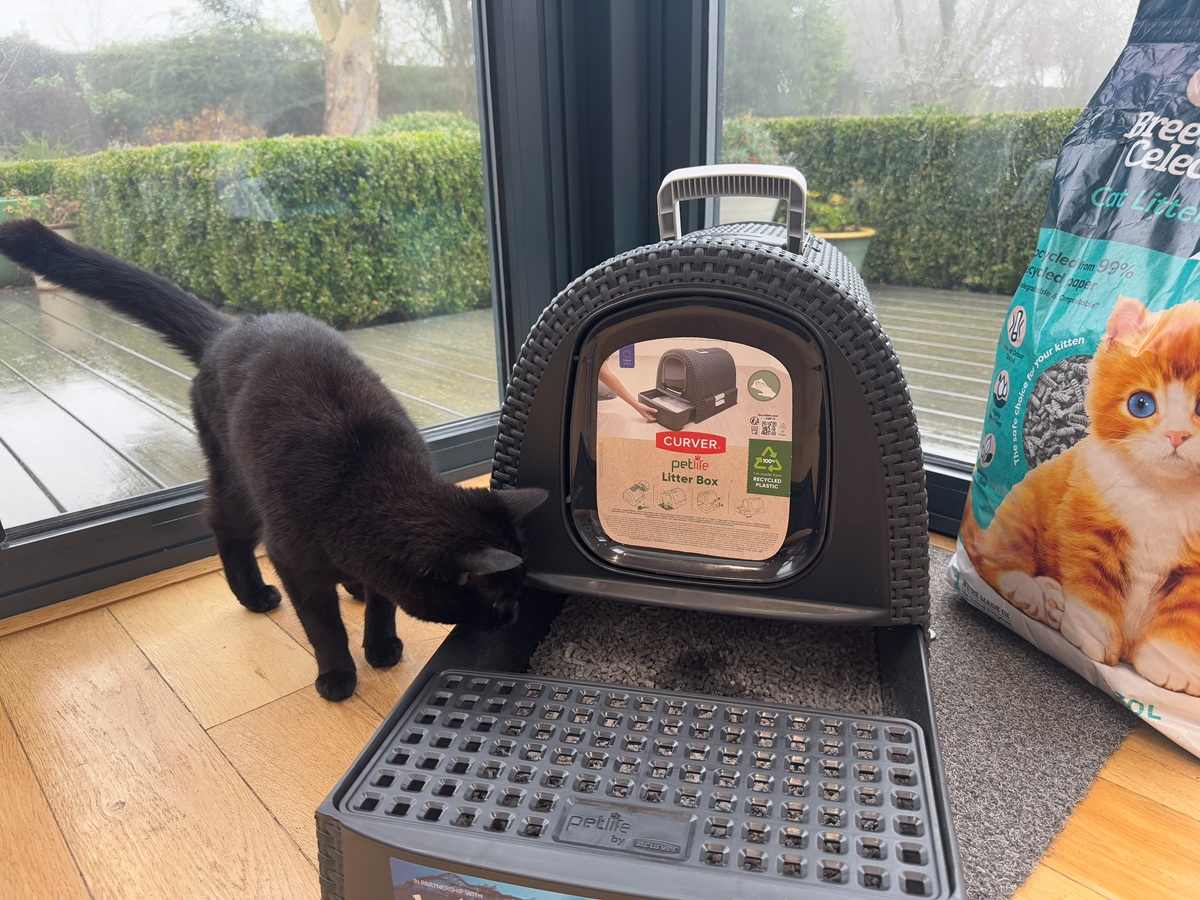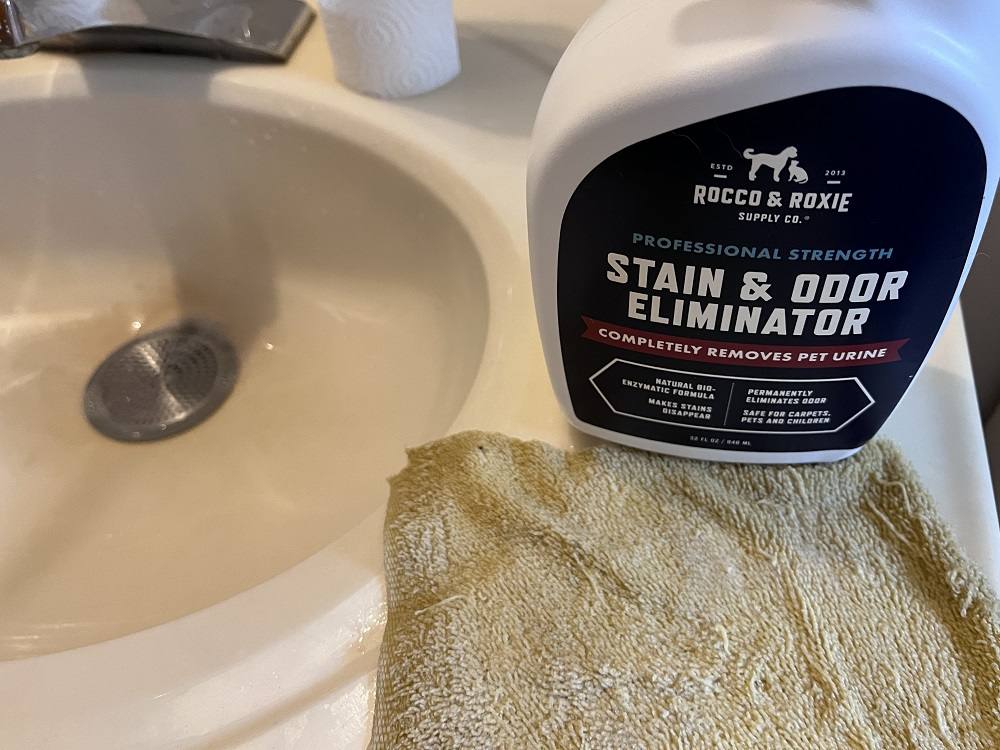
Emma Williams / Cats.com
With such rigorous bathing schedules, cats are known to be very tidy creatures. But they are downright useless with a litter scoop and broom. I used to find myself in a nonstop battle with far-flung granules and layers of chalky dust that collected on every last surface. Kittens are especially messy! It can be an unsightly—and smelly—situation.
Waste patrol is not the funnest part of being a pet parent. But having a cat doesn’t mean you’re doomed to a life of messy floors or grimy shelves. Yes, maintaining a clean litter area requires some effort and you’ll never be 100% free of stray particles. But there are some tricks you can try to help conquer the litter box area.
1. High-Sided Litter Box
There are more options now than just the standard, old-school litter pan. For sprayers, diggers, and flingers, a high-sided litter box helps contain the mess. Look for a box with 8- to 12-inch sides. Just make sure it’s still accessible to your cat, especially if they’re older or struggle with mobility issues. Many models feature a lower entry point for easier access. You might also want to consider a litter box with removable sides to make scooping easier.
2. Top-Entry or Enclosed Litter Box

If your cat will use a top-entry litter box, it can help contain the scatter. Liz Coleman / Cats.com
Not all cats like them, but for those who do, a top-entry litter box does a pretty good job of keeping litter where it’s supposed to be. Boxes with roof access are ideal for enthusiastic diggers and scratchers who would otherwise toss litter right over the side. Plus, they prevent other pets or small children from sampling a scoop and scattering the evidence.
Some models, like the PetMate Top Entry Litter Box, even have a roof that doubles as a litter mat to catch extra particles as your cat exits the box. Just make sure your cat is spry enough to jump into this type of litter box. A covered litter box with a side entrance is another option, but these are not the perfect solution for every cat.
A covered box might not work for larger cats. Some cats might feel trapped and unsafe in a covered box. And some might even stage a potty strike and take their business elsewhere, such as the floor. If you decide to go this route, the Petphabet Jumbo Covered Litter Box is a great choice because it has a transparent cover that allows cats to see outside the box.
3. Stylish Litter Box Furniture
A multifunctional litter box enclosure brings both aesthetics and utility to the table. Litter box furniture comes in all types, styles, and finishes. It is a unique way to make a statement in your home—or to make it blend right in and disappear. You can find sleek sideboards, decorative end tables, and practical benches with space for your cat’s litter box.
Remember that your cat’s needs must come before aesthetics—if they won’t use it or if it is unsafe, it doesn’t matter how pretty it is! And be careful not to place any heavy storage or fragile decor on top.
4. Cat Litter Mat
For catching excess scatter, a good cat litter mat is indispensable. Get one for every litter box in your home and shake them out regularly. Look for mats with deep grooves, pockets, or rigid surfaces that remove litter grains from your cat’s paws before they track litter all over the house. A rubber mat with raised edges is also useful for catching errant streams of urine—plus it’s easier to clean than fabric or porous mats.
5. Litter Box Liners
Opinions on litter box liners are split in the cat parent community. Some cat parents consider them impractical and a waste of plastic, Others find they are worth it because they speed up the cleaning process and prevent litter residue from cementing to the sides of the box.
They can really be a terrific help for cat owners with disabilities or limited mobility who cannot scrub a dirty litter pan every month. If you decide to try litter liners, choose a brand made with heavy-duty material that won’t tear under pressure or against your cat’s claws.
6. Low-Tracking Cat Litter

Larger, pellet-style litter tends to track less than fine-grain litter. Kirsten McCarthy / Cats.com
Unfortunately,100% non-tracking cat litter simply doesn’t exist, but some do a much better job at staying put than others. The amount of tracking you experience comes down to two main points: litter weight and size. Although there are some benefits to lightweight litter (i.e., it’s easier to pour and carry), it comes with the downside of being easier for cats to fling around.
Size is important, too. Large pellets tend to track less than fine, sand-like clay litter. The larger the pellet, the less likely it is to get stuck in your cat’s paws and be scattered across the floor. You are probably also familiar with it sticking to the bottom of your own feet. Litter with a smoother texture tends to track less than litter with a rough surface.
7. Litter Box Placement
This one can be tricky in a lot of homes. If at all possible, avoid placing the litter box in a high-moisture area like the bathroom, as the humidity can cause the litter to clump more and stick to the bottom of your cat’s paws.
If your space allows, place the box in a discreet area so there’s less mess where family members tend to hang out. Keep it far away from carpeted floors, which are much harder to clean than hard floors. And consider what else litter can get stuck in—floor vents, rugs, nooks, and crannies.
8. Your Cleaning Routine
There’s no way around it—having a litter box requires regular cleaning. The quicker you pick up stray particles, the less chance they have of spreading across your home. The litter box itself should be scooped daily. The more often this happens, the less likely your cat is to boycott the box and pee elsewhere.
Shake out your litter mat and vacuum or sweep around the box whenever a mess appears. That’s the mess that sticks to your own feet and causes that dreadfully cringey feeling. A full change of fresh litter should happen every few weeks, with non-clumping litter needing even more frequent changing.
9. Organized Litter Supplies

With cleaning supplies at the ready, regular maintenance is more feasible. Katelynn Sobus / Cats.com
Easy access to cleaning supplies will make you more likely to tidy up the area whenever you notice it getting dingy. Put everything you need in a container by the litter box, hang tools on an adjacent wall, or stash it all in the nearest closet. Just make it easy for yourself so you have fewer excuses to skip it.
Some things to have handy include:
- A high-performing litter scoop (yes, it makes a difference!)
- Waste bags or a cat litter pail
- A handheld dustpan and brush to sweep up scatter
- A compact, handheld vacuum (especially if your litter area is carpeted)
- A lint roller (the sticky surface can pick up small particles from the floor)
- Wipes or cleaning spray for spot-cleaning
10. Automatic Litter Box
We get it—keeping up with the litter box is tough. Make things easier on yourself with an automatic litter box that does the scooping for you. You won’t be off the hook completely, as these still need to be cleaned routinely. But it could be a nice timesaver, as long as your cat will use it.








I have not had cats since I was 15, suddenly God sent me three at 73? It took a while to figure out the cat box thing. Now I use either Home Depot or Lowe’s Moving boxes. Just slide the litter box in after cutting one side out. This works well as I use packaging tape to keep the box bottom from leaking, I was always told neutered males did not spray, that is false obviously.